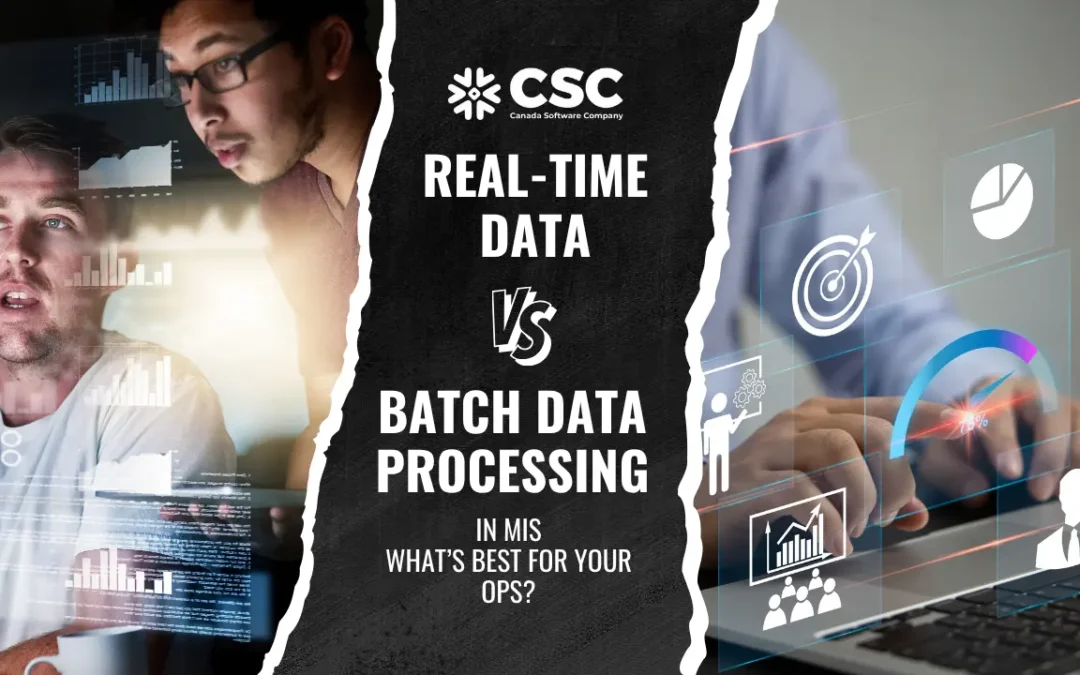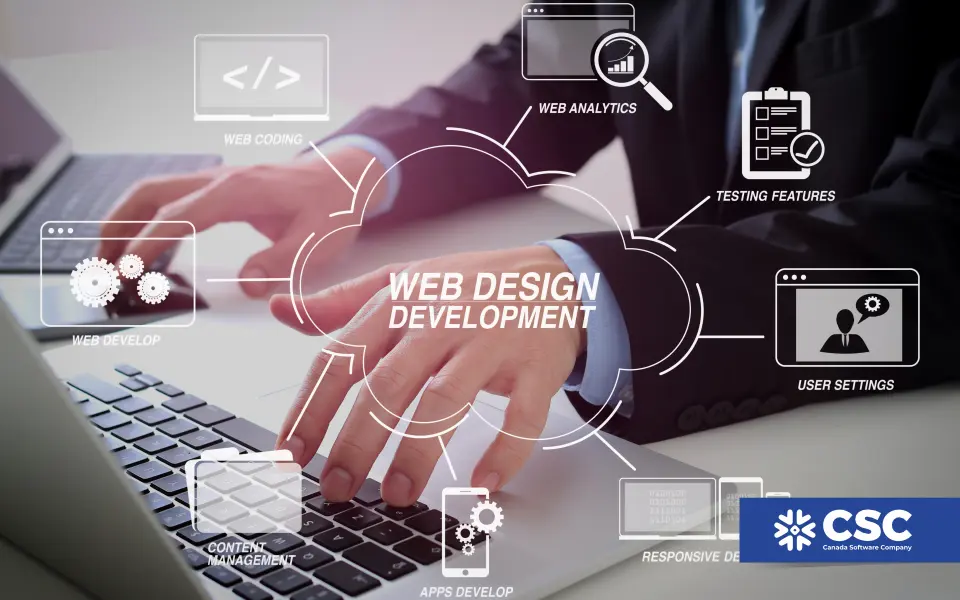
Real-Time vs. Batch Data Processing in MIS: What’s Best for Your Ops? 2025
Real-Time vs. Batch Data Processing in MIS: What’s Best for Your Ops? 2025
Boost Your MIS with the Right Data Processing Strategy
Welcome to Canada Software Company’s expert breakdown on the evolving world of data pipelines. In this post, we’ll explore batch data processing vs. real-time data processing , dive into industry specific use cases and help you choose what’s best for your Management Information System (MIS). Whether you’re scaling up compliance, chasing efficiency or building smart systems this blog is for you.
1. What Is Real-Time Data Processing and How Does It Work?
Real-time data processing refers to the instant analysis of data as it’s generated, offering actionable insights within milliseconds or seconds.
Real-World Canadian Example:
- Interac’s payment system detects and blocks fraudulent debit card transactions in real-time.
- The City of Toronto uses real-time IoT sensors to manage smart traffic lights dynamically.
What Does It Mean?
To define real time processing: it’s when data is processed immediately, helping organizations react instantly to critical events.
2. What Is Batch Data Processing and How Does It Fit Big Data?
Batch data processing involves collecting large volumes of data and processing them in scheduled intervals daily, weekly or monthly.
Canadian Batch Examples:
- The Canada Revenue Agency (CRA) runs nightly jobs to reconcile taxpayer filings.
- Hydro Québec processes electricity usage data in hourly or daily chunks.
Batch jobs can output data to file stores, relational databases or be part of a data pipeline that supports BI tools.
3. Batch vs Real-Time: A Side-by-Side Comparison
| Feature | Real-Time Processing | Batch Data Processing |
|---|---|---|
| Latency | Milliseconds to seconds | Minutes to hours |
| Input | Dynamic, continuous | Static, pre-collected |
| Use Cases | Fraud alerts, IoT, live dashboards | Payroll, ETL, analytics |
| Tools | Apache Kafka, Flink, Storm | Apache Spark, Hadoop, AWS Glue |
| Output | Alerts, live visual dashboards | Reports, warehouse tables |
| Error Handling | Handled instantly, requires monitoring | Detected post-processing |
| Data Accuracy | May risk inconsistency | High accuracy and completeness |
| Scalability | Requires robust infrastructure | Easier to scale with cloud-based solutions |
| Compliance Fit | Real-time AML, real-time alerts | Regulatory audits, end-of-day reconciliation |
4. What Are the Advantages and Disadvantages of Real-Time Processing?
Batch data processing involves collecting large volumes of data and processing them in scheduled intervals daily, weekly or monthly.
Pros of Real Time Processing:
- Instant insights for time-sensitive actions
- Great for fraud prevention, real-time personalization
- Supports IoT, AI, and dynamic dashboards
Cons of Real Time Processing:
- Requires high-performance architecture
- More complex to manage and monitor
- Susceptible to data anomalies in live streams
5. What Are the Pros and Cons of Batch Processing?
Pros of Batch Processing:
- Efficient for large data volumes
- Lower infrastructure cost
- Easier maintenance and debugging
Cons Batch Processing:
- Delayed insights
- Inflexible for changing needs
- Error propagation can affect entire datasets
6. How Is Real-Time Data Processing Used in Canadian MIS?
In Canada, MIS systems benefit from a real time approach to process control in critical sectors:
Healthcare: Vital sign monitors alert doctors in real-time.
Manufacturing: Factories in Ontario use sensors to control robotic arms.
7. What Is Batch Processing in Big Data Pipelines?
Batch processing shines in ETL workflows, where:
- Data is gathered from multiple systems
- Transformed into usable formats
- Loaded into data lakes or warehouses like Snowflake or BigQuery
Example: Large e-commerce retailers run inventory reconciliation nightly using Spark.
8. Real-Time Digital Signal & Image Processing in Action
Fields like medical diagnostics and autonomous vehicles depend on:
- Real-time image processing (e.g., CT scans)
- Signal processing in smart devices (e.g., voice recognition)
Canadian research contributes to publications like the Journal of Real-Time Image Processing.
9. What’s the Difference Between Online and Real-Time Processing?
- Online Processing: Immediate but not always constant (e.g., submitting a tax return).
- Real-Time Processing: Continuous, dynamic and uninterrupted (e.g., fraud alert systems).
10. What Are Some Common Real-Time Processing Examples?
- Interbank fund transfers (Interac)
- Uber driver location updates
- Smart meter readings from Hydro One
11. What Are Batch Processing Use Cases in Canada?
- Payroll: Run every 2 weeks for national workforces
- Data warehousing: Energy consumption reports
- Financial Reports: CRA end-of-day reconciliations
12. Real-Time vs. Batch Processing: Performance Factors
| Criteria | Real-Time | Batch |
|---|---|---|
| Speed | Instantaneous | Scheduled, slower |
| Complexity | High – continuous streams | Low – finite datasets |
| Tools | Kafka, Flink, AWS Kinesis | Spark, Glue, Dataflow |
| Storage Needs | Less storage, continuous flow | More storage, historical retention |
13. Real-Time vs Batch: Industry-Specific Use Cases in Canada
| Industry | Real-Time Processing | Batch Processing |
|---|---|---|
| Banking | Fraud detection, real-time approvals | End-of-day settlement, AML logs |
| Retail | Real-time cart abandonment tracking | Monthly sales reports |
| Healthcare | Emergency response alert systems | Historical analysis of treatments |
| Manufacturing | Real-time machinery control | Batch quality checks |
| Government | Immigration alerts, CRA fraud checks | Tax filing reconciliation |
14. Hybrid Processing: Best of Both Worlds
Many Canadian businesses are adopting hybrid data processing systems:
- Real-time for alerts, transactions and monitoring
- Batch for BI, compliance reports and audits
Example: Smart Utility Platform
- Real-time IoT detects leaks instantly
- Batch jobs send monthly usage and billing summaries
15. Real-Time & Batch Processing in Canadian Compliance & Regulation
For financial institutions, the choice impacts:
- AML compliance
- Data retention laws
- Transaction integrity
- Real-time alerts for immediate suspicious transactions
- Batch archives for audits, inspections and legal records
16. Decision Guide: Choosing the Right Data Processing Method for Your Org
| Question | If YES → | If NO → |
|---|---|---|
| Do you need instant action on data? | Real-time | Batch |
| Is the data volume high and periodic? | Batch | Real-time |
| Can your org support low-latency infra? | Real-time | Batch |
| Do you need historical trend analysis? | Batch | Real-time |
| Are you combining live feeds with reports? | Hybrid | Choose one |
Conclusion
Both real-time and batch data processing are vital for building intelligent, responsive, and scalable MIS solutions. At Canada Software Company, we help you implement the right mix based on:
- Your data frequency
- Compliance requirements
- Budget and technical capacity
Ready to build your modern MIS? Contact us for a tailored consultation.
Make Better Decisions: Start with These FAQs
What is real-time data processing in simple terms?
Real-time data processing means handling data right when it comes in. You don’t wait for it to get processed instantly. This is great for things that need quick action, like fraud alerts or live updates.
What are some real-time data processing examples in Canada?
In Canada, real-time processing is used in:
Interac payment systems to stop fraud
Smart traffic lights that adjust based on live road activity
Hospital monitors that track patient vitals and alert doctors right away
What is batch data processing used for?
Batch processing is best when you gather data first, then process it later. It’s used for:
Running payroll every two weeks
Creating audit reports
Updating data warehouses with sales or customer information
Can batch processing output to a database?
Yes, batch processing can send results to:
Relational databases like MySQL or PostgreSQL
Cloud warehouses like Amazon Redshift or Google BigQuery
Is real-time data processing expensive?
Yes, it can be. You need fast computers, strong internet and special tools to keep things running 24/7. That makes it costlier than batch processing.
Which is better: real-time or batch processing?
Neither is better for all cases. Use real-time when you need speed. Use a batch when timing isn’t urgent but you’re working with a lot of data.
Which AWS service is best for real-time data processing?
Amazon Kinesis is a top choice. It helps you collect, process and analyze streaming data quickly. You can also use AWS Lambda with Kinesis for event-based processing or Amazon MSK for Apache Kafka users.
What advantages does real-time processing offer over batch processing?
Real-time processing gives you:
Instant decisions from live data
Real-time alerts to stop problems quickly
A better customer experience, since everything feels faster
How does a batch operating system differ from a real-time operating system?
A batch operating system runs groups of jobs at once, like in payroll systems. It’s not time-sensitive.
A real-time operating system (RTOS) reacts instantly to inputs. Think of autopilot software or heart monitors—it must respond right away.





